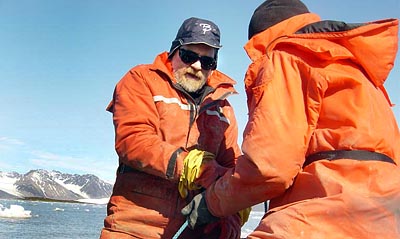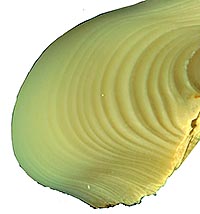Of Climate, Clams, and Colleagues
Professor Will Ambrose, a bearded biologist specializing in Arctic sea-floor ecology, is a pioneer in the science of deciphering the past — including past climates — by studying the annual hard-tissue accretions of organisms such as mollusks.
As an expert in sclerochronology, Ambrose has discovered a link between Arctic clam growth and regular shifts in the region’s climate. In short, Arctic clams grow more rapidly during regimes of warm and wet weather and less during cold and dry regimes. This sensitivity to climate change, says Ambrose, makes the humble bivalve a “sentinel of climate change.”

In Kongsfjorden on the west side of Svalbard, Will Ambrose (facing) and Kelton McMahon ’05 haul a dredge to collect Serripes groenlandicus and other clam species for McMahon’s thesis in 2004. Photograph by Glenn Lopez, SUNY–Stony Brook.
While Ambrose is collaborating on no fewer than five clamshell research projects at the moment, the scientific paper that detailed the initial findings of a correlation between climate change and Arctic clamshells appeared in Global Change Biology in September 2006.
 |
| Seen here is the cross section of a small portion of aSerripes groenlandicus shell, near the umbo, or hinge. The lines indicate annual growth: dark lines for slow winter growth; light areas indicate fast summer growth. For an image showing the complete shell, click here.
Will Ambrose has discovered a correlation between growth and climate shifts. This image is a composite of 18 images produced by the College’s new Imaging and Computing Center using a Nikon SMZ 1500 stereo microscope. Collected in 1926, the shell’s actual length is 2.5 inches. |
The paper emerged from work done three years earlier, when Ambrose dispatched divers to the bottom of a high Arctic fjord in the Svalbard archipelago, a popular Arctic research site about halfway between the Norwegian mainland and the North Pole. From the ocean bottom, the divers returned with four Greenland cockles (Serripes groenlandicus).
After encasing the shells in epoxy and slicing them apart, Ambrose and a team of scientists, including Kelton McMahon ’05, analyzed the growth bands. First, the team found that growth bands were indeed deposited annually. Then the team was able to correlate annual differences in shell growth with a measurement of Arctic weather oscillations known as the Arctic Climate Regime Index.
“What makes the work exciting,” says Ambrose, interviewed in his cluttered office on Carnegie’s third floor, “is that this is the first time in the Arctic that we’ve been able to track a large-scale climatic oscillation and see that large-scale regional event reflected in animals living on the bottom.”
While scientists have for decades analyzed growth lines in shells (Ambrose and others call them “trees of the sea”) in order to reconstruct past environments, the intensity around climate-change research has “really made the field of sclerochronology take off,” he says.
In this hot field, Ambrose’s research is distinctive for its location, on the Arctic continental shelf. “A lot of the work has been done at lower latitudes, mostly because it’s harder to get clams in the Arctic and there are simply fewer people available to help,” he says. “That’s why we’re ahead of the ball.”
If it’s true that Arctic clams grow faster in warmer weather (and grow faster when there’s less of a seasonal ice pack, another signal that Ambrose saw hints of), a simplistic response might be, “Great — fatter clams for walruses to munch on.” But, explains Ambrose, fat clams won’t offset the problems walruses are having due to less pack ice to rest on. And less ice will also affect tiny creatures inside the ice that are the first link in a food chain for polar cod, seabirds, and seals. And so on, throughout the Arctic food web.

These Serripes groenlandicus clams were collected in Storfjord at a site last visited by 19th-century Russian explorers. Photograph by Greg Henkes ’08.
In the end, changes in water temperature and salinity (due to runoff from melting glaciers) and increased sea levels, leading to erosion and turbidity, will all take their toll on the Arctic ecology. “Ecosystems operate at the interface of physics, chemistry, and biology, with both complementary and contradictory interactions,” Ambrose writes in a forthcoming article predicting that “regional, and perhaps global, biodiversity will suffer.”
Until recently, Ambrose researched other organisms of the benthic community, such as bloodworms along Maine’s coast. A simple matter of funding helped bring bivalves into focus, as a Bates grant (from the Philip J. Otis Endowment) and an external one (from the Howard Hughes Medical Institute) helped purchase a pricey Isomet low-speed saw for preparing shell cross-sections. “Very expensive,” Ambrose says.
In researching the biological response of Arctic bivalves to climate change, Ambrose has depended on the interests and expertise of colleagues and students at Bates and abroad.
Geology professor Beverly Johnson, for example, has been invaluable in co-advising biology students so they can learn to use the College’s stable isotope ratio mass spectrometer, a tool to help identify the age and origins of molecules in various materials. Johnson herself has used the instrument to look at amino acids in dinosaur eggs, and it can likewise be used to tease out the chemical components of clamshells.
“I work with Will to understand how modern systems work,” says Johnson, “and then go back to old shells, using the geochemistry of shells from 125,000 years ago to reconstruct the environment.”
Ambrose also depends on Matt Duvall, who directs Bates’ new Imaging Center, to create elegant microscopic images of his clamshell sections that Ambrose calls “just incredible.”
Geology professor Mike Retelle, another Svalbard regular who specializes in reconstructing climates from lake sediments, has collaborated with Ambrose on researching climate-change information from fossilized Ice Age clams.
Beyond the sciences, Ambrose, Johnson, and Retelle belong to an informal North Atlantic Study Group on campus that also includes archeologists Gerald Bigelow and Bruce Bourque, historian Michael Jones, and political scientist Áslaug Ásgeirsdóttir. What started informal — an interdisciplinary coffee klatsch — has given rise to “North Atlantic Studies,” a thematic grouping of Bates courses, known as a concentration, under the College’s new general education requirements. “We represent an area of study, rather than just a bunch of us sitting around having coffee,” Ambrose says.
“It’s a truly special group,” Retelle adds. “The richness of discussion is such that the boundaries between disciplines disappear. The walls of the box dissolve. Will is a big part of that. As a model for an undergraduate institution, Will has really raised the bar.”
Ambrose himself is quick to point out that “students here are the ones driving the bus in terms of getting the work done.” As he speaks, Greg Henkes ’08 of Chapel Hill, N.C., is downstairs in the environmental geochemistry lab cutting shells and extracting organic material. Henkes’ senior thesis involves a study of 130 years of climate change in the Barents Sea and Svalbard using a historic Russian collection of Serripes groenlandicus. He will present his findings to an American Geophysical Union conference in San Francisco.

Greg Henkes ’08, one of Will Ambrose’s thesis students, took this photograph at 3 a.m. on June 3, 2007, as the research shipLance heads through sea ice in Storfjord in the Svalbard archipelago, about halfway between the North Pole and Norway.
“It’s pretty incredible to be able to do this at Bates,” says Henkes. “It’s the way science is going,” says Ambrose of the collaborative nature of scientific enquiry, noting his international partnerships with colleagues at the Norwegian Polar Institute and the research firm Akvaplan-niva. “People aren’t doing their own little thing anymore.”
“That’s the way science should be done,” emphasizes Kelton McMahon, co-author of the Serripes groenlandicus paper. “In certain circles, it is. But a lot of people come from departments that don’t share data because they feel funding is in direct competition. Bates takes a very progressive approach to interdisciplinary research.”
McMahon is now working on his Ph.D. in a program co-sponsored by MIT and the Woods Hole Oceanographic Institution. His contribution to the clamshell research has been to use two gizmos — a New Wave Research UP213 laser ablation system coupled to a Thermo Finnigan Element 2 single collector field inductively coupled plasma mass spectrometer — to measure the chemical components of shell samples. Ambrose et al. used changes in the ratio of strontium to calcium to establish that the external lines of the Greenland cockleshells were, in fact, annual growth lines. “If it wasn’t for Kelton getting us access to those machines,” says Ambrose, “the paper wouldn’t have been anywhere near as good.”
As he sits in his Carnegie office discussing his work — Ambrose also hopes to extend his sclerochronology research to coral in part because “they live much longer than clams” — he is eagerly awaiting a new shipment of Svalbard shells that he hopes will solve a quirk in his findings. Until recent years, Ambrose found that annual clam growth was high in years when the extent of Arctic ice pack, as measured each March, was low. But over the last several years, “growth didn’t track ice cover the way it did before. Something happened, but we’re not sure what,” he says. “Are the last four years unnatural? That’s why I want those new clams. It’s another four years of data that will help establish some baselines.” And baselines will help provide more answers, which will probably just beget more questions. It’s the way scientific inquiry works. “People like simple answers,” Ambrose says. “Nature doesn’t.”
Freelance writer Edgar Allen Beem wrote about the College’s sustainability initiatives in the Fall 2007 issue of Bates Magazine.